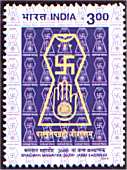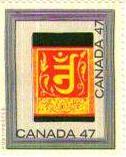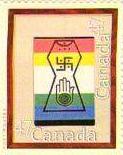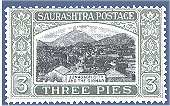 | The first stamp on Jainism was issued in India by Saurashtra State, a part of India before Independence on October 18, 1929. This three pies stamp bears a view of Girnar Hills where 23rd Jain Tirthankar Neminath Bhagwan had attained Nirvana. Girnar is an important Jain pilgrimage centre. Indian Government issued first stamp on Jainism on May 6, 1935 bearing Sheetalnath Jain Temple of Calcutta. |
 | The first stamp on Jainism to be issued from outside India came from East Germany. On 23 August, 1979 the East German Postal Department issued a set of four stamps on Indian miniature paintings. One of these showed the beautiful painting of Lord Mahaveer from the fifteenth or sixteenth century. |
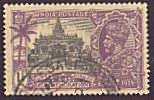 | On May 6, 1935 Indian Government issued first stamp on Jainism depicting Sheetalnath Jain Temple of Calcutta (now Kolkata) which was constructed in the year 1868 A.D. It is famous for its artistic patch work with coloured mirror-glass pieces and enamel on its walls and ceiling. This one & quarter anna stamp was part of a set of four stamps of temples and shrines issued to commemorate the Silver Jubilee of King George V's regime. |
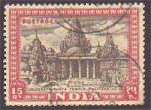 | A stamp worth Rs.15/- depicting the Shatrunjaya Temple of Palitana (Gujrat) was issued on 15th August 1949. It is first Tirthankara Bhagwan Rishabhnath's temple built in the year 1618 A.D. and famous for its excellent fine carvings and architecture. This stamp was part of first archeological definitive series of 16 stamps. |
 | The one rupee stamp bearing the photo of a sculpture of a lady writing a letter was issued by the Department of Posts, India on July 1, 1966 as part of the 3rd definitive series on archaeology. The sculpture is from the famous Parshwanath Jain Temple of Khajuraho. |
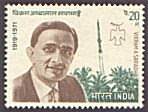 | World renowned nuclear and space scientist of India Dr. Vikram Ambalal Sarabhai was the first Jain dignitary honoured by the Government of India by issuing a stamp on his first death anniversary on 30th December 1972. This 20 paisa stamp was issued showing him with his ROHINI rocket and a dove. He was the father of India's space programme. |
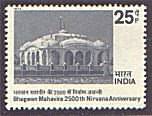 | On the occasion of 2500th Nirwan Anniversary of Bhagwan Mahaveer, a stamp worth 25 paise was issued on 13th November 1974. The stamp depicted the lake temple Jal-Mandir of Pavapuri (Bihar) where Bhagwan Mahaveer attained Nirwan, the salvation. |
  | On the occasion of World Hindi Convention, oa stamp was issued on January 10, 1975 and on the occasion of World Telgu Conference another stamp was issued on April 12, 1975. Both these stamps depict the photograph of the attractive 12th century image of Goddess Saraswathi. This idol was taken from a Jain Temple in village Palloo, District Bikaner and presently exhibited is National Museum, New Delhi. |
 | A 25 paisa stamp was issued on 27th July 1978 under the `Treasures of Museum' series on Kutch Museum showing an ancient wood carving of a mythological Airawat elephant. This beautiful piece wood carving was taken out from an ancient Jain temple of Gujarat and is now exhibited in Kutch Museum. |
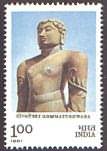 | Bhagwan Bahubali was son of Tirthankar Bhagwan Rishabhadev. A 58 feet high idol of Bahubali called Gomateshwar was erected by the Chamundaraya, a royal minister, on the top of a 300 feet high hill at Shravanbelgola (Karnataka) in the year 981 A.D. The idol is one of the wonders of the world attracting tourists from all over the world. On the occasion of the millennium year celebrations of the idol, a one rupee stamp was released on 9th February 1981 by Indian Postal Department |
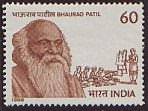 | Famous Jain philanthropist Dr. Karmveer Bhaurao Patil devoted his whole life to the task of rural mass education and upliftment and welfare of the depressed and down trodden, emphasising the removal of untouchability and advocating equality. A stamp was issued on 9th May 1988 in his honour. |
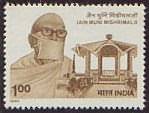 | Spiritual Saint and Philosopher Jain Muni Mishrimalji was a profound orator. He had written in lot of literature in Sanskrit, Hindi, Urdu, Prakrit and Rajsthani languages. More than 5000 pages of prose and poetry are their to his credit. He fought against Socio-religious superstitions, evil practices and led Social reformation movement. A stamp was issued in his memory on 24th August 1991. |
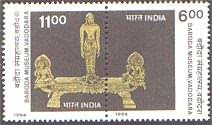 | A `se-tenant pair' (set of two stamps) was issued on 20th December 1994 to celebrate the centenary of Baroda Museum. The se-tenant stamp had the picture of an ancient 6th century bronze statue of Bhagwan Rishabhnath exhibited in the Baroda Museum. Bhagwan Rishabhnath is regarded as the eighth incarnation of Lord Vishnu. |
 | World renowned Jain philosopher Dr. Jagdish Chandra Jain was the authority on Jain studies. He had written more than eighty books and received several awards including Soviet Land Nehru Award. He was honoured by issuing a stamp on 28th January 1998. |
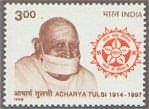 | Famous Jain saint Acharya Tulsiji took asceticism at an early age of 11 and at 22 he was appointed Acharya. He launched the "Anuvrat Movement" for reinforcement of human values in life, giving the slogan "Self discipline alone is the life". He established Jain Vishwa Bharti and took the herculean task of research on Jain Agams and published their critical editions in 32 volumes. A stamp was issued on him on 20th October 1998. |
 | The Millennium celebrations of the world famous Jain Khajuraho Temples were organised by the Indian government between March 1999 and March 200. To commemorate the occasion this stamp issued on 6 March 1999 depicts the beautiful lady Apsara removing a thorn from her foot: The original statue is in the Parshwanath Jain Temple of Khajuraho. |
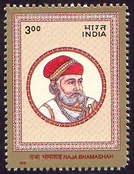 | Jain Raja Danveer Bhamashah was a childhood friend, a colleague and a very faithful advisor of Mewar king Maharana Pratap. Bhamashah's loyal support was pivotal to the career of Maharana Pratap. When Maharana Pratap was defeated, Bhamashah had given his complete wealth to Maharana Pratap in his fight for India's freedom, that too at a time when the king had lost all hopes and was hiding in mountains to save his family. On 31st December 2000 Indian Postal Department issued a set of four stamps on historical personalities which included one on Bhamashah. |
| | On the occasion of the 2600th Janma Kalyanak (Birth Anniversary) year of the 24th Jain Tirthankara Bhagwan Mahaveer, Indian Postal Department had issued a Rs. 3/- denomination stamp on 6th April 2001. This stamp depicts the unique symbol summarising Jain teachings of Ahimsa Paramodharma adopted with the words Parasparopagraho Jivanam by all Jain groups. |
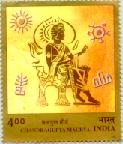 | On 21st July 2001, a stamp has been issued on the historical Jain ruler Samrat Chandragupta Maurya who stands out as one among the most colorful personalities of Indian history. He conquored many states including Magadha and formed a vast Mauryan Empire with the capital at Pataliputra in 322 B.C. He established a well-organized administrative system and gave it a sound financial base, thus laying the foundation for an enduring empire. During his regin India prospored and developed a lot in the terms of Trade & Commerce, Art & Culture. Becaming deciple of Jain Muni Bhadrabahu Swami, he adopted Jainism. |
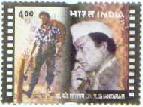 | On the occasion of Birth Centenary of the pioneer of Indian film industry and renouned Jain Film Producer Shri V. Shantaram a stamp was issued on 18th Nov. 2001. He was born in a reputed Jain family at Kolhapur and honoured with 'Jain Samaj Ratna' award and also with Padmabhushan in 1992. He has been connected a a with various film institutions, being a member of the Film Advisory Board and Central Board of Film Censors. He was the founder President of the Film Producers Guild of India, member of the S. K. Patil Film Inquiry Committee, and founder member of the Children's Film Society. |
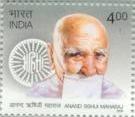 | Acharya Anand Rishiji Maharaj was born at Ahmadnagar (Maharastra) in August 1900 and at the age of 13, commited himself to a life of spiritual pursuits and service to humanity. He was proficient in nine languages and Mastered the Jain Scriptures as well as ancient philosophical texts of Sanskrit language. His teachings were deep rooted in love, non-violence and tolerance. He had founded numerous educational and religious institutions. He was bestowed with the title of "Acharya" in the year 1965 and died in the year 1992. On his Birth centenary a stamp was issued on 1st august 2002. |
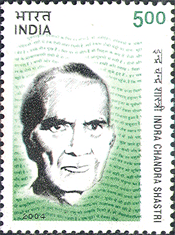 | A stamp was issued on 27th May 2004 on great philosopherand exceptional author Pro. Dr. Indra Chandra Shastri. He was a pursuer of individual spiritualism who was inspired by Jain Anekanta. Born on May 27, 1912 at Dabwali Mandi (Haryana). He campaigned against Bal Diksha, a practice of forcible adoption of poor children by Jain ascetics in Rajasthan, prevalent in those days. This resulted in the tabling of a bill in the Assembly of Bikaner. As a recognition of his pioneering efforts and creative talent, he was awarded the ‘Sahitya Seva Samman’, by the Hindi Academy, ‘Sahitya Ratna Alankaran’ by the Vice-Chancellor of Delhi University and ‘Certificate of Honor’ by the President of India. Dr. Indra Chandra Shastri passed away on November 3, 1986. |
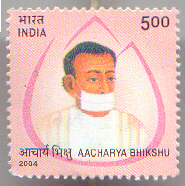 | Founder of the Jain Swetamber Terapanth Sect Aacharya Bhikshu was a philosopher saint, perceptive writer, sensitive poet and social reformer. He composed about 38000 shlokas and his writings have been compiled in two volumes as "Bhikshu Granth Ratnakar". He was born on the thirteenth day of the Ashad in the Vikram Samvat year 1783, in the village Kantaliya (Rajasthan). He took to ascetic life under the guidance of Acharya Raghunathjiand established the Terapanth religious Sangha on 28th June 1760. He attained eternal bliss in the Vikram Samvat year 1860 at Siriyari, Rajasthan. On 30th June 2004, Indian Postal department has issued a stamp on him. |
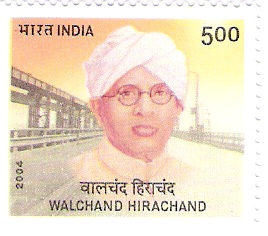 | The visionary Jain industrialist Walchand Hirachand was pioneer of India's automobile, shipping and aircraft manufacturing sectors. He was a dreamer, a visionary, a great builder, a great leader of industry. Above all, he was a patriot, and in his own way, he was an inspiring leader of our struggle for freedom. To mark his 121st birth anniversary, a Rs.5 postage stamp was released on 23rd Nov. 2004. |
 | Famous Jain personality of Maharashtra, late Mr. Jawaharlal Darda was a veteran freedom fighter, Congress leader and founder of the Lokmat group of newspapers. Born on July 2,1923, Mr. Darda joined the freedom struggle at the age of 17 and participated in the Quit India Movement in 1942. He launched “Nave Jag”, a weekly newspaper in the year 1947 and “Lokmat” in 1952. He made a mark in the governance in Maharastra by his admirable handling of the portfolios of energy, industry, irrigation, health, food and civil supplies, sports, youth affairs, textiles and environment as a Minister. This stamp was issued on 2nd Dec. 2005. |
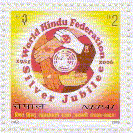 | Nepal issued this stamp on 6th April 2006 to commemorate Silver Jubilee of World Hindu Federation. This stamp depicts JAIN PRATIKA (symbol) which was adopted by all the Jain sects during 2500th Nirwan Anniversary of Bhagwan Mahaveer in the year 1974. The outer line of the symbol denotes the TRILOK (three worlds). The palm denotes the fearlessness and forgiveness. The wheel is Dharma Chakra in the centre of which word AHIMSA (non-violence) is written. Swastik denotes prosperity on which three dots are the characters of human being- SAMYAK DARSHAN (right belief), SAMYAK GYAN (right knowledge) and SAMYAK CHARITRA (right conduct). The crescent denotes the SIDDHA BHOOMI and the upper dot denotes the SIDDHA, In the bottom a Sanskrit phrase " PARASPAROPAGRAHO JIVANAM" is written which means all the human beings help each other. |
more stamps:
